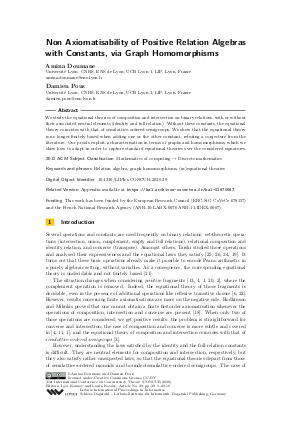Non Axiomatisability of Positive Relation Algebras with Constants, via Graph Homomorphisms
Authors Amina Doumane, Damien Pous
-
Part of:
Volume:
31st International Conference on Concurrency Theory (CONCUR 2020)
Part of: Series: Leibniz International Proceedings in Informatics (LIPIcs)
Part of: Conference: International Conference on Concurrency Theory (CONCUR) - License:
 Creative Commons Attribution 3.0 Unported license
Creative Commons Attribution 3.0 Unported license
- Publication Date: 2020-08-26
File

PDF
LIPIcs.CONCUR.2020.29.pdf
- Filesize: 0.54 MB
- 16 pages
Document Identifiers
Related Versions
-
Appendix available at https://hal.archives-ouvertes.fr/hal-02870687.
Subject Classification
ACM Subject Classification
- Mathematics of computing → Discrete mathematics
Keywords
- Relation algebra
- graph homomorphisms
- (in)equational theories
Metrics
- Access Statistics
-
Total Accesses (updated on a weekly basis)
0Document
0Metadata
Abstract
We study the equational theories of composition and intersection on binary relations, with or without their associated neutral elements (identity and full relation). Without these constants, the equational theory coincides with that of semilattice-ordered semigroups. We show that the equational theory is no longer finitely based when adding one or the other constant, refuting a conjecture from the literature. Our proofs exploit a characterisation in terms of graphs and homomorphisms, which we show how to adapt in order to capture standard equational theories over the considered signatures.
Cite As Get BibTex
Amina Doumane and Damien Pous. Non Axiomatisability of Positive Relation Algebras with Constants, via Graph Homomorphisms. In 31st International Conference on Concurrency Theory (CONCUR 2020). Leibniz International Proceedings in Informatics (LIPIcs), Volume 171, pp. 29:1-29:16, Schloss Dagstuhl – Leibniz-Zentrum für Informatik (2020)
https://doi.org/10.4230/LIPIcs.CONCUR.2020.29
BibTex
@InProceedings{doumane_et_al:LIPIcs.CONCUR.2020.29,
author = {Doumane, Amina and Pous, Damien},
title = {{Non Axiomatisability of Positive Relation Algebras with Constants, via Graph Homomorphisms}},
booktitle = {31st International Conference on Concurrency Theory (CONCUR 2020)},
pages = {29:1--29:16},
series = {Leibniz International Proceedings in Informatics (LIPIcs)},
ISBN = {978-3-95977-160-3},
ISSN = {1868-8969},
year = {2020},
volume = {171},
editor = {Konnov, Igor and Kov\'{a}cs, Laura},
publisher = {Schloss Dagstuhl -- Leibniz-Zentrum f{\"u}r Informatik},
address = {Dagstuhl, Germany},
URL = {https://drops.dagstuhl.de/entities/document/10.4230/LIPIcs.CONCUR.2020.29},
URN = {urn:nbn:de:0030-drops-128411},
doi = {10.4230/LIPIcs.CONCUR.2020.29},
annote = {Keywords: Relation algebra, graph homomorphisms, (in)equational theories}
}
Author Details
Funding
This work has been funded by the European Research Council (ERC-StG CoVeCe 678157) and the French National Research Agency (ANR-10-LABX-0070 ANR-11-IDEX-0007).
References
- H. Andréka and D.A. Bredikhin. The equational theory of union-free algebras of relations. Algebra Universalis, 33(4):516-532, 1995. URL: https://doi.org/10.1007/BF01225472.
- Hajnal Andréka and Szabolcs Mikulás. Axiomatizability of positive algebras of binary relations. Algebra universalis, 66(7), 2011. An erratum appears at http://www.dcs.bbk.ac.uk/~szabolcs/AM-AU-err6.pdf. URL: https://doi.org/10.1007/s00012-011-0142-3.
- D. A. Bredihin and B. M. Schein. Representations of ordered semigroups and lattices by binary relations. Colloquium Mathematicae, 39(1):1-12, 1978. URL: http://eudml.org/doc/266458.
- D. A. Bredikhin. The equational theory of relation algebras with positive operations. Izv. Vyssh. Uchebn. Zaved. Mat., 37(3):23-30, 1993. In Russian. URL: http://mi.mathnet.ru/ivm4374.
-
Paul Brunet. The equational theory of algebras of languages. Talk at RAMiCS, Lyon, May 2017 (Special session on mechanised reasoning), 2017.

- Paul Brunet and Damien Pous. Petri automata for Kleene allegories. In LICS, pages 68-79. ACM, 2015. URL: https://doi.org/10.1109/LICS.2015.17.
- Chandra Chekuri and Anand Rajaraman. Conjunctive query containment revisited. Theoretical Computer Science, 239(2):211-229, 2000. URL: https://doi.org/10.1016/S0304-3975(99)00220-0.
-
R. Diestel. Graph Theory. Graduate Texts in Mathematics. Springer, 2005.

- Amina Doumane and Damien Pous. Completeness for identity-free Kleene lattices. In CONCUR, volume 118 of LIPIcs, pages 18:1-18:17. Schloss Dagstuhl, 2018. URL: https://doi.org/10.4230/LIPIcs.CONCUR.2018.18.
- Amina Doumane and Damien Pous. Full version of this paper, with appendices, 2020. URL: https://hal.archives-ouvertes.fr/hal-02870687.
- Z. Ésik and L. Bernátsky. Equational properties of Kleene algebras of relations with conversion. Theoretical Computer Science, 137(2):237-251, 1995. URL: https://doi.org/10.1016/0304-3975(94)00041-G.
- Eugene C. Freuder. Complexity of k-tree structured constraint satisfaction problems. In NCAI, pages 4-9. AAAI Press / The MIT Press, 1990. URL: http://www.aaai.org/Library/AAAI/1990/aaai90-001.php.
-
P. Freyd and A. Scedrov. Categories, Allegories. North Holland, 1990.

- Jay L. Gischer. The equational theory of pomsets. Theoretical Computer Science, 61(2):199-224, 1988. URL: https://doi.org/10.1016/0304-3975(88)90124-7.
-
J. Grabowski. On partial languages. Fundamenta Informaticae, 4:427-498, 1981.

- Martin Grohe. The complexity of homomorphism and constraint satisfaction problems seen from the other side. Journal of the ACM, 54(1):1:1-1:24, 2007. URL: https://doi.org/10.1145/1206035.1206036.
-
T. Hoare, B. Möller, G. Struth, and I. Wehrman. Concurrent Kleene algebra and its foundations. Journal of Logic and Algebraic Programming, 80(6):266-296, 2011.

- Ian Hodkinson and Szabolcs Mikulás. Axiomatizability of reducts of algebras of relations. Algebra Universalis, 43:127-156, 2000. URL: https://doi.org/10.1007/s000120050150.
-
Roger Maddux. Relation Algebras. Elsevier, 2006.

- Szabolcs Mikulás. Axiomatizability of algebras of binary relations. In Classical and New Paradigms of Computation and their Complexity Hierarchies, pages 187-205. Springer Netherlands, 2004. URL: https://doi.org/10.1007/978-1-4020-2776-5_11.
- Donald Monk. On representable relation algebras. The Michigan mathematical journal, 31(3):207-210, 1964. URL: https://doi.org/10.1307/mmj/1028999131.
- Yoshiki Nakamura. Partial derivatives on graphs for kleene allegories. In Lics, pages 1-12. IEEE, 2017. URL: https://doi.org/10.1109/LICS.2017.8005132.
- Damien Pous and Valeria Vignudelli. Allegories: decidability and graph homomorphisms. In LiCS, pages 829-838. ACM, 2018. URL: https://doi.org/10.1145/3209108.3209172.
-
V. Pratt. Origins of the calculus of binary relations. In LICS, pages 248-254. IEEE Computer Society Press, 1992.

-
A. Tarski. On the calculus of relations. J. of Symbolic Logic, 6(3):73-89, 1941.

-
A. Tarski and S. Givant. A Formalization of Set Theory without Variables, volume 41 of Colloquium Publications. American Mathematical Society, Providence, Rhode Island, 1987.

